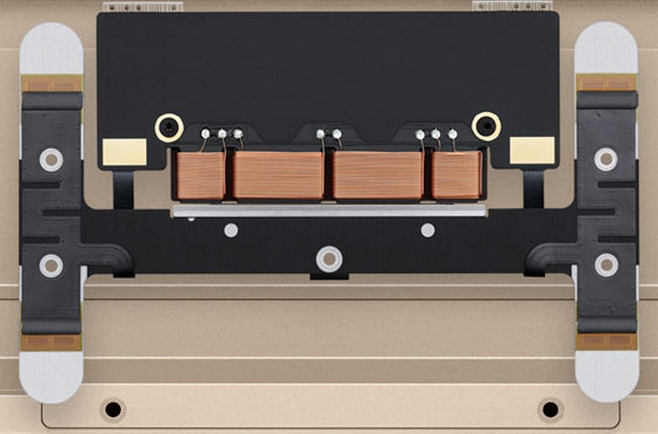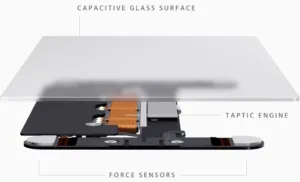Apple’s March 9, 2015 press event disclosed a fairly extensive range of new products and initiatives. As I reported in my prior Display Daily (Notebook Computer Displays Evolve), the new MacBook (available April 10) comprises some interesting design features that result in a very thin, capable notebook computer with very low weight and long battery life.

The new MacBook’s input devices include a very low profile keyboard based on a new “Butterfly” key mechanism. The MacBook also incorporates a “Force Touch” trackpad (photos below).
Source: Apple
 Source: Apple
Source: Apple
The trackpad incorporates haptic feedback which Apple provides via the firm’s “Taptic Engine” which “provides a click sensation when you press anywhere on the (trackpad) surface”. The multi-touch force sensing trackpad provides an extended user interface capability that enables gesture-force-based input combined with haptic feedback.
Apple describes three use cases and the gesture vocabulary associated with gesture-force-based input: force click, accelerators, and pressure-sensitive drawing. Apple describes “Force click” stating: “Click and continue to press on the trackpad to enable new capabilities, like looking up the definition of a word, previewing a file in the Finder, or creating a new Calendar event when you Force click a date in the text of an email”. The accelerator use case is described as: “Gradually add pressure to the trackpad to vary the speed with which you fast-forward through a QuickTime movie or zoom in on a location in Maps”. Finally, pressure-sensitive drawing is described as you would expect: “Press lightly for a thin stroke or harder for a thick one”. We will have to wait until users can actually try the new MacBook to see if this extended gesture input vocabulary is embraced by users.
Apple is also providing other signals that point the way to potential user interface advances. In a patent application (PDF file) published March 19, 2015, Apple reveals a haptics-based user input system that provides for haptic feedback and spatial localization of that haptic feedback in a user input device such as a virtual keyboard or keypad. For the keyboard of the new MacBook, Apple employed the Butterfly key mechanism which enabled both a thinner keyboard design and more precise typing action. Users of touch screen devices are familiar with the general lack of tactile feedback associated with typing on a virtual keyboard. In the new patent application, Apple lays out a virtual keyboard input device incorporating localized haptic feedback at each key location which if successfully implemented could lead to very thin virtual keyboards for notebooks and other mobile devices that offer improved typing characteristics. – Phil Wright

